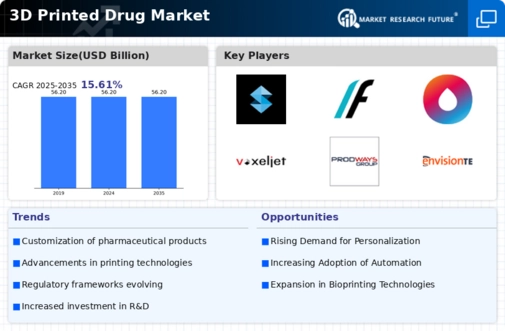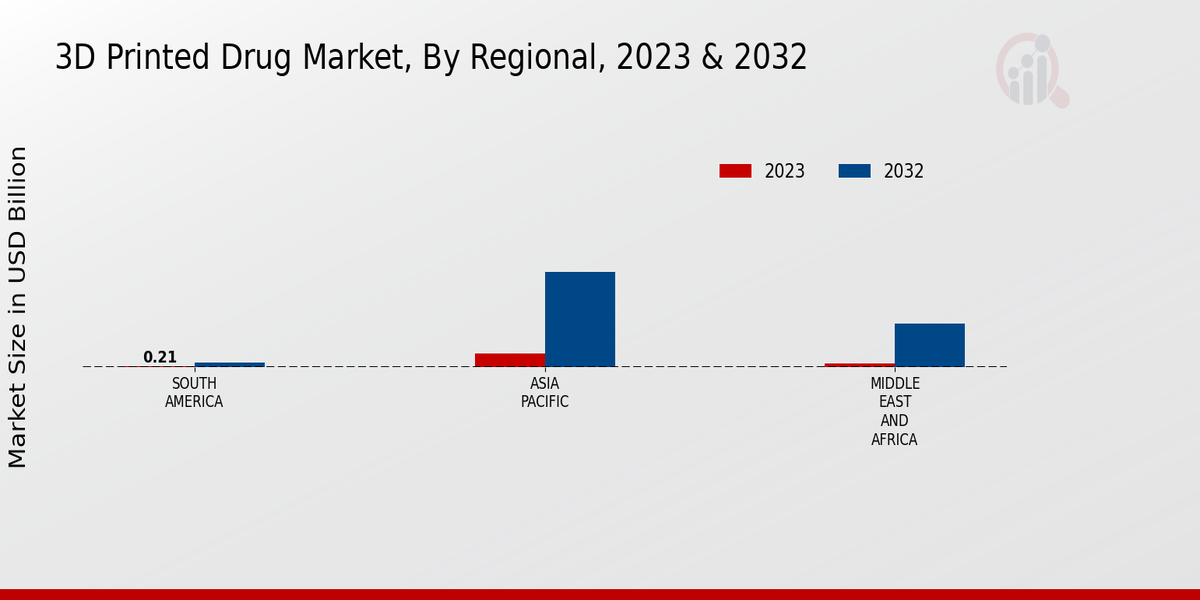Cost Efficiency
Cost efficiency is a crucial factor propelling the Global 3D Printed Drug Market Industry forward. Traditional drug manufacturing processes often involve high production costs and extensive supply chains. In contrast, 3D printing allows for localized production, reducing transportation costs and minimizing waste. This efficiency not only lowers the overall cost of drug production but also enables rapid prototyping and iteration of drug formulations. As companies increasingly adopt 3D printing technologies, the market is expected to stabilize, with a projected CAGR of 0.0% for 2025-2035. This stability suggests that cost-effective solutions will continue to play a vital role in the industry's evolution.
Regulatory Support
Regulatory bodies are increasingly recognizing the potential of 3D printing in pharmaceuticals, which is positively influencing the Global 3D Printed Drug Market Industry. Initiatives aimed at streamlining the approval process for 3D printed drugs are emerging, as seen in the FDA's guidance on additive manufacturing. This regulatory support fosters innovation and encourages pharmaceutical companies to invest in 3D printing technologies. As a result, the market is likely to expand, with expectations of reaching 56.2 USD Billion by 2035. Such developments indicate a growing acceptance of 3D printed drugs within established regulatory frameworks.
Global Health Initiatives
Global health initiatives aimed at improving access to medications are influencing the Global 3D Printed Drug Market Industry. Organizations and governments are exploring innovative solutions to address medication shortages and improve distribution in underserved regions. 3D printing technology offers a promising avenue for producing essential drugs on-site, thereby enhancing accessibility. For example, initiatives in developing countries are leveraging 3D printing to create affordable medications tailored to local health challenges. This focus on accessibility is likely to drive market growth, as the industry adapts to meet the needs of diverse populations around the world.
Market Growth Projections
The Global 3D Printed Drug Market Industry is poised for growth, with projections indicating a market value of 56.2 USD Billion by 2024 and maintaining this value through 2035. The anticipated CAGR of 0.0% for the period from 2025 to 2035 suggests a stabilization of the market as it matures. This growth trajectory reflects the industry's ability to adapt to changing healthcare demands and technological advancements. As the market evolves, stakeholders are likely to focus on enhancing production capabilities and expanding applications of 3D printing in pharmaceuticals, ensuring sustained interest and investment in this innovative sector.
Technological Advancements
The Global 3D Printed Drug Market Industry is experiencing rapid technological advancements that enhance drug formulation and manufacturing processes. Innovations in 3D printing technologies, such as bioprinting and multi-material printing, allow for the creation of complex drug delivery systems tailored to individual patient needs. For instance, companies are developing personalized medications that can be produced on-demand, reducing waste and improving patient adherence. As these technologies evolve, they are expected to drive market growth, with the industry projected to reach 56.2 USD Billion by 2024. This growth reflects a shift towards more efficient and patient-centric healthcare solutions.
Rising Demand for Personalized Medicine
The increasing demand for personalized medicine is a significant driver of the Global 3D Printed Drug Market Industry. Patients are seeking treatments that are tailored to their unique genetic profiles and health conditions. 3D printing technology enables the customization of drug dosages and formulations, allowing for more effective treatment plans. This trend is evident in the development of patient-specific medications that can be produced quickly and efficiently. As the market adapts to these demands, it is projected to maintain a steady trajectory, with a forecasted value of 56.2 USD Billion by 2024, reflecting the industry's responsiveness to evolving healthcare needs.























